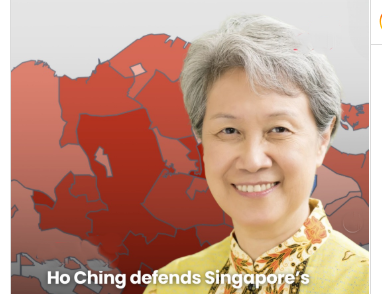There has been a lot of public debate about the Temasek Chairman salary, or more precisely, the executive compensation plan associated with Temasek’s leadership. The salary range ascribed to its former CEO, Ho Ching, who is often the subject of both awe and speculation, is especially startling. The top executive position at Temasek pays between $82.2 million and $90.7 million a year, according to Glassdoor estimates. This amount naturally raises questions. The underlying narrative, however, shows a much more complex structure than what viral claims might imply.

According to the data, bonuses and other performance-linked incentives contribute an estimated $61.3 million annually, while the average base salary is $25 million. These bonuses do not come with a guarantee. Rather, they are linked to meticulously assessed performance metrics and frequently postponed over a number of years, occasionally retracted if returns fall short of expectations. Because of this, the overall compensation structure is incredibly successful at coordinating long-term value creation with individual reward.
Temasek Chairman (Former CEO Ho Ching) – Profile Summary
| Full Name | Ho Ching |
|---|---|
| Date of Birth | March 27, 1953 |
| Nationality | Singaporean |
| Education | Electrical Engineering, NUS; MSEE, Stanford |
| Key Roles | CEO of Temasek Holdings (2004–2021), Chairman |
| Family Connection | Spouse of PM Lee Hsien Loong |
| Leadership Traits | Visionary, discreet, performance-driven |
| Known For | Strategic reforms, ESG advocacy, risk governance |
| Source |
Ho Ching was the target of baseless salary rumors during her time there. Independent blogs and social media platforms, including The Online Citizen, reported that she was paid at least S$100 million a year. Temasek, however, swiftly and adamantly refuted such numbers, stating that she wasn’t even among the top five earners at the company and that her pay was significantly less than that amount. The purpose of that clarification, which was given in incredibly clear language, was to correct the false information that was quickly spreading online.
Temasek’s Board and Leadership Development and Compensation Committee (LDCC) independently oversee the company’s compensation policy. It is the responsibility of this committee to find a delicate balance between promoting accountability and stifling creativity. The LDCC makes sure that compensation stays fair, open, and sustainable by utilizing internal performance metrics, international standards, and structured bonuses. Notably, even though it owns stock in Temasek, the Singaporean government has no say in or authority over executive compensation.
Temasek’s structure looks especially creative and well-balanced when compared to executive compensation around the world. The top executives at Temasek have a longer time horizon than CEOs in the private sector, who might look to quarterly profits to support stock-linked bonuses. There are short-, medium-, and long-term goals in the framework. It is only when genuine value is proven over years, not months, that deferred rewards become available. The clawback mechanism, which returns previous bonuses for poor performance, adds a level of discipline that is uncommon in similar institutions.
In contrast, based solely on yearly performance, the heads of significant U.S. hedge funds such as Citadel or Bridgewater frequently surpass the $100 million threshold. In contrast, Norway’s Government Pension Fund Global prioritizes stability and conservative management while providing more modest compensation packages. Temasek falls somewhere in the middle of this spectrum, emphasizing performance while keeping public accountability in mind.
Ho Ching’s public position as Singapore’s prime minister’s wife further muddies the perception of her salary. Her business choices and state matters continued to be distinct, but the overlap fueled public conjecture. Her reputation for tact, unwavering diligence, and long-term planning, however, largely held steady. She set an example, frequently working behind the scenes to steer the fund’s transition toward responsible capitalism, according to former staff members and financial analysts.
Under Ho Ching’s direction, Temasek has expanded dramatically over the last 20 years, both in terms of the assets it manages and its strategic reach. Beyond conventional markets, the fund started to place a strong emphasis on healthcare, renewable energy, and ESG initiatives. These changes, which were motivated by risk diversification and long-term thinking, brought Temasek into line with new international ideals. In addition to overseeing assets, Ho Ching was influencing global capital trends. Her choices frequently mirrored Singapore’s resilient and pragmatic investment philosophy.
Temasek’s incorporation of sustainability metrics into pay decisions was especially creative. The organization redefined what successful investing could mean by measuring social impact in addition to profits. This strategy was similar to efforts at progressive companies like BlackRock, which started giving executive appraisals a higher priority for ESG objectives. These patterns show a global realignment in which performance is now evaluated in terms of broader societal contribution rather than just financial return.
Temasek’s dedication to good governance is further demonstrated by its insistence on independence in compensation planning. The business is not state-run, but it is state-linked. By making this distinction, financial incentives are protected from changes in politics. Temasek protects its professional integrity by implementing international best practices, such as the use of independent compensation committees and international benchmarking.
Crucially, the public debate surrounding the Temasek Chairman’s pay also reflects a larger social change. Transparency, equity, and responsible capitalism are becoming more and more popular. This entails a shift away from opaque practices and toward proactive clarification and open communication for state-affiliated funds such as Temasek. An incredibly clear illustration of how organizations can regain control over narratives that could otherwise degenerate into false information was Temasek’s response to salary rumors.
Even now, Temasek and other industries are still under scrutiny. The public’s desire to learn more about executive compensation is only increasing, whether it is for media titans like Bob Iger or tech CEOs like Elon Musk. The public now demands values-driven leadership in addition to performance. Because of this fact, Temasek’s model is especially advantageous due to its hybrid identity, which comfortably balances market discipline with state mission.
